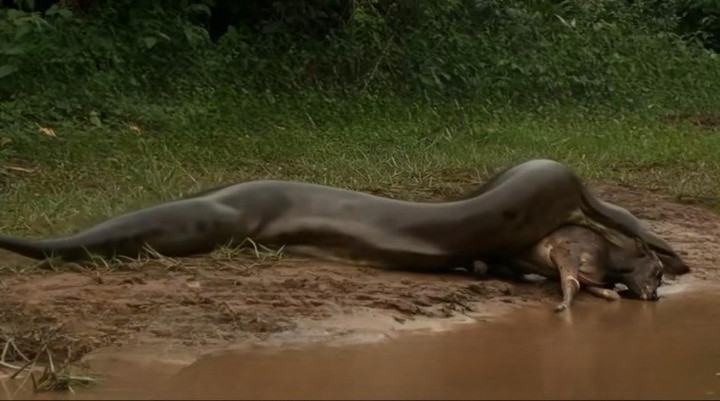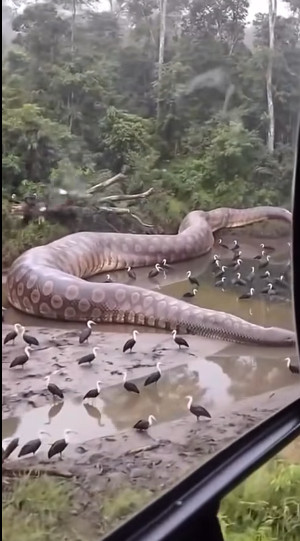The Viral Anaconda Video: Unraveling Nature’s Myths in the Age of Social Media
In the dynamic landscape of the internet, the convergence of shock, fascination, and skepticism often creates viral sensations that captivate audiences worldwide. Over the past decade, platforms like TikTok and Instagram have transformed fleeting moments into cultural phenomena, with users drawn to content that appears too astonishing to be real. One such piece of footage that captured widespread attention is a purported video of the world’s largest anaconda consuming a horse in one massive gulp. The video sparked an immediate whirlwind of discussions, raising questions about the authenticity of the clip and the truths surrounding nature’s most formidable predators.
From the moment the video surfaced, it ignited fierce debate among viewers. Some argued that they had witnessed irrefutable evidence of the anaconda’s terrifying capabilities, while others speculated about potential digital manipulation or sleight of hand. The question loomed large: could a snake, no matter how legendary, realistically achieve such a feat? Was this video a manifestation of humanity’s longstanding fascination with dramatic displays of nature, or was it simply a clever fabrication designed to elicit shock and awe? As the footage circulated across social media platforms like TikTok, Facebook, and Twitter, it quickly transformed from mere entertainment into a significant point of cultural discussion.
The Biology of the Anaconda: Myths and Realities
To understand the possibilities illustrated in the viral video, it’s essential to delve into the biology of the green anaconda. These massive snakes, known scientifically as Eunectes murinus, are among the largest and heaviest reptiles on the planet, capable of reaching lengths of over 29 feet and weights exceeding 550 pounds. Anacondas are non-venomous constrictors, relying on their immense size and muscular strength to subdue prey. They typically hunt aquatic animals, such as fish and birds, but they are also known to tackle larger mammals, including deer and capybaras.
However, the notion of an anaconda ingesting a horse whole raises significant questions. While it is true that these snakes can consume large prey, the logistics of swallowing a creature as formidable as a horse—particularly in one fluid motion—seems highly improbable. Experts in herpetology emphasize that even the largest snakes would struggle with the physical constraints of their jaws and digestive systems when confronting prey of such size. For instance, the jaw of a green anaconda can dislocate, allowing it to swallow sizable creatures, but the sheer volume and form of a horse pose challenges that are not easily overcome. This biological understanding casts doubt on the authenticity of the viral video and invites viewers to reconsider the narratives that sensationalize nature’s capabilities.

The Psychology Behind Viral Media
The viral nature of this anaconda video can also be attributed to psychological factors that dictate how we consume media in the digital age. Humans are inherently drawn to the extraordinary; images and stories that evoke strong emotional responses—whether fear, awe, or disbelief—tend to spread rapidly across social networks. This phenomenon is further amplified by the algorithms of social media platforms, which prioritize engaging content that captures viewers’ attention. The algorithms are designed to keep users scrolling, feeding them more of what they engage with, which is often sensational content like the anaconda video.
Moreover, the concept of “clickbait” plays a significant role in content virality. The headlines accompanying sensational videos often exaggerate or distort the truth, tempting viewers to click and share regardless of the factual basis. In the case of the anaconda video, the allure lies not only in the shocking premise but also in the broader commentary it elicits about our relationship with nature, the unknown, and the limits of what we understand about the animal kingdom. This relationship between humans and media is complex, often leading to a cycle where myth and reality blur, creating a fertile ground for misinformation.
A Cultural Obsession: Giants of the Animal Kingdom
Throughout history, humanity has been captivated by stories of colossal creatures and the mysteries they embody. From the legendary tales of dragons to the awe-inspiring accounts of massive dinosaurs, these narratives reflect a deep-rooted fascination with the larger-than-life phenomena of our world. The viral anaconda video taps into this cultural obsession, amplifying our collective curiosity about predators that exist at the fringes of our understanding. This obsession is not merely a modern phenomenon; it echoes through centuries of folklore and mythology, where giants and monsters often symbolize humanity’s fears and aspirations.
Moreover, the viral nature of such content can also be linked to the way our society processes fear. Predators like the anaconda evoke a primal fear, rooted in our survival instincts. This adrenaline rush mingled with curiosity leads viewers to share the video, sparking further discussions on the subject. As we navigate a landscape filled with compelling yet ambiguous media, it becomes imperative to approach such content with a critical eye. The excitement surrounding the viral anaconda footage serves as a reminder of our responsibility as consumers of information. It encourages us to differentiate between sensationalism and reality, to seek understanding, and to foster a deeper appreciation for the natural world and its mysteries.
Conclusion: The Intersection of Nature and Digital Culture
The viral anaconda video exemplifies the complex interplay between nature, storytelling, and the digital age. As we grapple with the implications of such content, we must also recognize the power of media to shape our perceptions and beliefs. Whether this particular video reveals truth or illusion, it undeniably serves as a catalyst for discussion and exploration into the incredible world of wildlife. Ultimately, it urges us to remain curious yet discerning, fostering a culture that values both the awe-inspiring wonders of nature and the responsibility of authentic storytelling. Understanding the nuances of our interactions with media, especially in relation to our views on nature, is imperative for fostering a more informed public discourse.

















